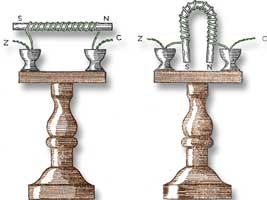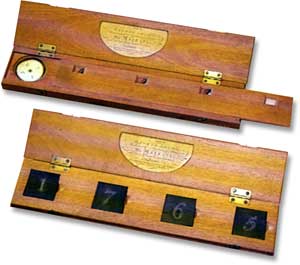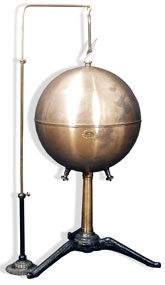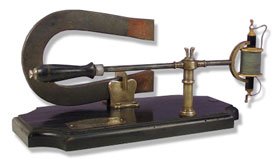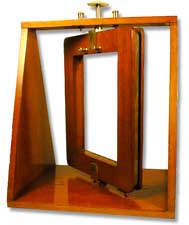| Contact |
| Back | Next | Home |
Magnetism and Electromagnetism
Development of the Electromagnet
In 1819, Hans Oersted (1777-1851) found that an electrical current, when passed through a straight piece of wire, deflected the needle on a compass. He published his findings in a small pamphlet in 1820, probably one of the last great scientific discoveries to be published entirely in Latin.
|
|
His discovery showed there was a connection between electricity and magnetism and prompted a whirlwind of further investigation by others. In 1825 William Sturgeon developed the first practical electromagnet by loosely winding a coil of un-insulated wire around a horseshoe-shaped piece of iron. To prevent the wire from shorting Sturgeon coated the iron in varnish. The seven-ounce magnet was able to support nine pounds of iron using the current from a single cell.
In 1830, Joseph Henry dramatically improved on Sturgeon's electromagnet by using cotton insulated wire (probably the first time this was done) and winding hundreds of turns around an iron core. With other modifications, Henry constructed 21-pound "experimental magnet" able to support 750 pounds.
Magnetic/Electromagnetic Apparatus from the collection:

Apparatus to Demonstrate Oersted's Discovery
likely by Watkins and Hill
1830-1845

Collection of Electromagnets Including red and green painted coil by Daniel Davis (12 o'clock in illustration) circa 1840's; Watkins and Hill electromagnet (3 o'clock, circa 1840's); English horseshoe electromagnet(6 o'clock) circa 1870's; Primitive electromagnet, American circa 1830's (9 o'clock) circa 1830-1845
|

Electromagnet with Three Poles |
|||
|
Helix on Stand
|
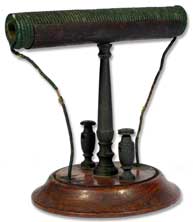
Helix on Stand |
|||
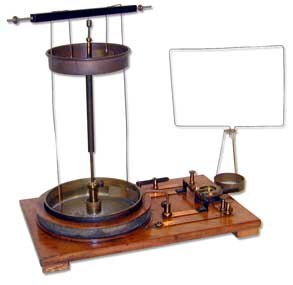 Ampère Table Named for André-Marie Ampère, (1775 - 1836) This is an early model of the same apparatus constructed by Ampere for his famous experiments on the relationship between magnetic fields and electric current. |
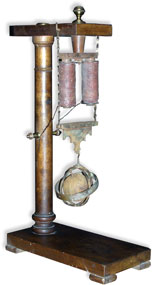 Early Electromagnet Demonstration Apparatus - 1852
|
|||
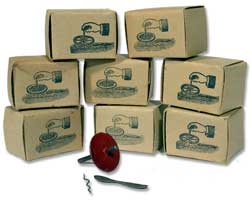
Ten Small Toy magnetic Tops |
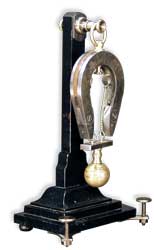 Permanent Magnet Demonstration Apparatus 1860 This device is similar to the electromagnet demonstration below, except that a horseshoe permanent magnet is used. |
|||
|
||||
|
|
||||
|
||||
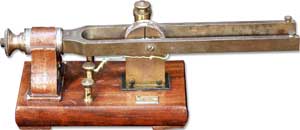
Tuning Fork Audio Oscillator |
Groves Earth Coil A coil of wire mounted to a commutator rotated so as to cut the lines of force of the earth's magnetic field, thereby generating a potential difference. This apparatus was used to demonstrate the earth's magnetic field.
|
|||
 GROUP OF COMPASSES English Last Quarter, 18th Century. From left to right: (1) Pocket compass - mahogany box measures 2" x 2" with primitive triangular shaped hinges; in very fine condition: See pg 443. Public and Private Science; The King George III Collection, fig. E68; (2) Pocket Compass - signed "Benjn Pike, Optician and Philosophical Instrument Maker, 12 Wall St. New York" Same as above except measures 2-5/8 " square and is painted/waxed red on top of box enclosure. Benjamin Pike Sr., was at this business address from 1804 to 1831; it is very rare to find instruments signed by Benjamin Pike, Sr. (3) Pocket Compass - same as above except measures 4" x 4" and has square hinges. |
||||
| Contact |
| Back | Next | Home |
